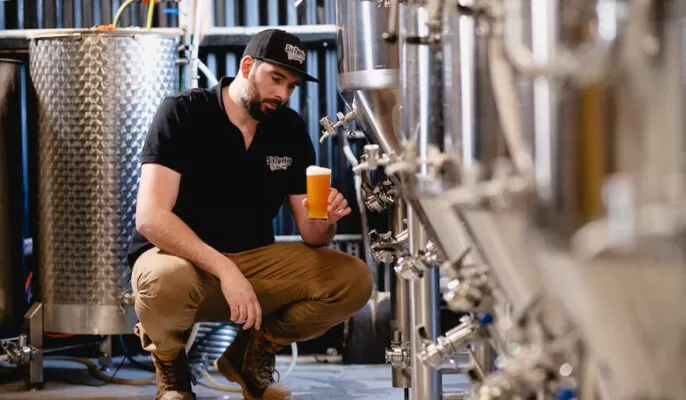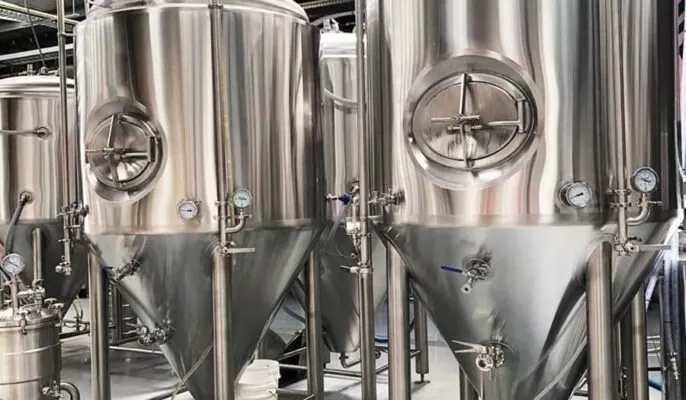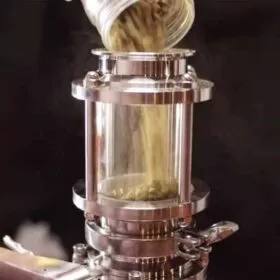독특한 풍미와 장인의 손길을 거친 맥주를 찾는 맥주 애호가들이 늘어나면서 최근 몇 년 동안 수제 맥주의 인기는 경이적으로 상승했습니다. 모든 성공적인 수제 맥주 양조장 뒤에는 끊임없이 성장하는 이 산업의 요구를 충족하도록 설계된 다양한 특수 장비가 있습니다. 이 글에서는 양조장 장비의 다양한 유형, 필수 구성 요소, 올바른 장비를 선택할 때 고려해야 할 요소 등을 살펴보며 양조장 장비의 세계에 대해 자세히 알아볼 것입니다. 이제 차가운 맥주 한 잔을 들고 다음과 같은 여정을 시작해보세요. 소규모 양조장 장비!
소규모 양조장 장비란 무엇인가요?
자세한 내용을 살펴보기 전에 소규모 양조장 장비가 무엇을 수반하는지 이해하는 것이 중요합니다. 간단히 말해, 소규모 양조장 장비는 소규모로 수제 맥주를 생산하는 데 사용되는 기계와 도구를 말합니다. 대규모 상업용 양조장과 달리 소규모 양조장은 품질과 실험에 중점을 두고 제한된 수량의 맥주를 생산하는 데 중점을 둡니다.
소규모 양조장 장비의 종류
양조장을 설립할 때 양조 과정에 필수적인 다양한 유형의 장비가 있습니다. 다음은 몇 가지 주요 유형의 양조장 장비입니다:
- 양조장 장비: 양조장은 맥주 양조 과정이 이루어지는 양조장의 핵심입니다. 일반적으로 여러 구성 요소가 포함됩니다:
- 매시 툰: 맥아 곡물을 뜨거운 물과 섞어 매싱하는 동안 당분을 추출하는 용기.
- 양조 주전자: 끓이는 주전자라고도 하며, 맥아즙을 끓이고 홉을 넣는 데 사용됩니다.
- 뜨거운 주류 탱크: 양조 과정에 사용되는 뜨거운 물을 저장합니다.
- 월풀: 끓인 후 뜨거운 찌꺼기(침전물)를 맥아즙에서 분리하는 데 사용됩니다.
- 발효 장비: 발효는 효모가 당분을 알코올로 전환하는 맥주 생산의 중요한 단계입니다. 발효 장비에는 다음이 포함됩니다:
- 발효기: 맥아즙이 발효되고 효모가 당분을 알코올과 이산화탄소로 전환하는 용기입니다.
- 브라이트 탱크: 컨디셔닝 탱크 또는 숙성 탱크라고도 하는 이 탱크는 맥주의 2차 발효 및 청징에 사용됩니다.
- 맥아즙 냉각 및 여과 장비: 끓인 후 맥아즙을 식히고 여과해야 합니다. 이 장비에는 다음이 포함됩니다:
- 플레이트 냉각기: 뜨거운 맥아즙을 빠르게 냉각하는 열교환기입니다.
- 열교환기: 뜨거운 맥아즙에서 차가운 물로 열을 전달하는 장치입니다.
- 여과 시스템: 고형물, 침전물, 안개를 제거하여 맥주를 맑게 하는 데 사용됩니다.
- 저장 장비: 셀러링 장비는 발효 후 맥주를 컨디셔닝하고 숙성시키는 데 사용됩니다. 여기에는 다음이 포함됩니다:
- 숙성 탱크: 원하는 맛과 향을 내기 위해 맥주를 특정 기간 동안 숙성시키는 용기입니다.
- 배럴: 배럴 숙성 맥주에 사용되며, 나무에서 나오는 독특한 풍미를 선사합니다.
- 케깅 시스템: 맥주 통에 맥주를 담아 유통 또는 서빙을 준비하기 위한 장비입니다.
- 포장 장비: 포장 장비는 맥주를 병에 담거나 통조림으로 만들어 유통할 준비를 하는 데 사용됩니다. 여기에는 다음이 포함됩니다:
- 보틀링 기계: 병을 채우고 뚜껑을 닫는 자동화된 시스템입니다.
- 통조림 라인: 캔을 채우고, 밀봉하고, 라벨을 붙이기 위한 장비입니다.
- 라벨링 시스템: 병이나 캔에 라벨을 부착하는 기계입니다.
- 제어 시스템: 소규모 양조장에서는 온도, 압력, 타이밍 등 양조 과정의 다양한 파라미터를 모니터링하고 제어하기 위해 제어 시스템을 활용하는 경우가 많습니다. 이러한 시스템은 맥주 생산의 일관성과 정밀성을 보장합니다.
- 청소 및 소독 장비: 양조 산업에서는 청결과 위생을 유지하는 것이 매우 중요합니다. 다음을 포함한 세척 및 살균 장비 클린인플레이스(CIP) 시스템으로 오염 물질을 제거하고 추출 장비의 위생 상태를 유지하는 데 도움이 됩니다.
다음은 양조업자가 고품질 수제 맥주를 생산하기 위해 사용하는 주요 유형의 소규모 양조장 장비입니다. 각 장비 유형은 양조 과정에서 특정 용도로 사용되며, 양조장의 생산 능력과 특정 양조 요구 사항에 따라 선택이 달라집니다.

소규모 양조장 장비의 필수 구성 요소
소규모 양조장 장비는 양조 과정과 양조장의 전반적인 기능에 기여하는 다양한 필수 구성 요소로 이루어져 있습니다. 이러한 구성 요소는 고품질의 수제 맥주를 효율적으로 생산하기 위해 함께 작동합니다. 다음은 소규모 양조장 장비에 포함된 주요 필수 구성 요소입니다:
- 제어 시스템: 제어 시스템은 브루잉 프로세스 전반에 걸쳐 다양한 파라미터를 조절하고 모니터링하는 중요한 구성 요소입니다. 여기에는 브루어가 온도, 압력, 타이밍 및 기타 중요한 변수를 관리하고 조정할 수 있는 센서, 프로브, 컨트롤러 및 소프트웨어가 포함됩니다. 이 제어 시스템은 브루잉 프로세스의 일관성과 정밀성을 보장합니다.
- 펌프: 펌프는 양조 시스템 내에서 액체를 이동하는 데 중요한 역할을 합니다. 펌프는 맥아즙, 맥주, 세척액 및 기타 유체를 여러 용기와 장비 간에 이송하는 역할을 합니다. 펌프는 원심 펌프와 양변위 펌프 등 다양한 유형으로 제공되며, 양조 공정의 특정 요구 사항에 따라 선택이 달라집니다.
- 난방 및 냉방 시스템: 가열 및 냉각 시스템은 추출 과정의 여러 단계에서 정확한 온도 제어를 유지하는 데 필수적입니다. 이러한 시스템에는 열교환기, 보일러, 냉각기, 냉각기 등이 포함됩니다. glycol systems. They enable brewers to heat the brewing water, control the temperature during mashing, cool the wort after boiling, and maintain fermentation temperatures within desired ranges.
- Grain Handling Equipment: Grain handling equipment is crucial for efficiently processing malted grains. This equipment includes grain mills, which crush the malted grains to expose the starches for extraction during mashing, and augers or conveyors, which help transfer the milled grains to the mash tun.
- 청소 및 소독 장비: Maintaining cleanliness and ensuring proper sanitization of brewing equipment is essential for producing high-quality beer. Cleaning and sanitization equipment includes Clean-in-Place (CIP) systems, which automate the cleaning process by circulating cleaning solutions through the brewing vessels and piping. This helps remove residual contaminants, yeast, and bacteria, ensuring hygienic brewing conditions.
- 발효 용기: Fermentation vessels, such as fermenters and brite tanks, are where the wort undergoes fermentation and conditioning. These vessels are typically made of stainless steel and often equipped with temperature control systems, pressure relief valves, and sanitary fittings to create an optimal environment for yeast activity and beer maturation.
- Packaging Components: Packaging components are essential for the packaging and distribution of the finished beer. They include carbonation systems, filling valves, keg couplers, bottle or can fillers, and labeling systems. These components help package the beer into bottles, cans, or kegs while ensuring proper carbonation and maintaining product quality.
- Valves and Fittings: Valves and fittings are crucial for controlling the flow of liquids and gases within the brewing system. They include ball valves, butterfly valves, sample valves, sight glasses, and sanitary fittings. These components enable brewers to control the movement of fluids during various stages of the brewing process, such as transferring liquids between vessels, controlling flow rates, and taking samples for quality testing.
These are some of the essential components found in microbrewery equipment. Each component plays a critical role in the brewing process, ensuring efficiency, control, and hygiene throughout the production of craft beer. The selection and integration of these components depend on the specific needs and scale of the microbrewery.
소규모 양조장 장비 선택 시 고려해야 할 요소
When choosing microbrewery equipment, several factors should be taken into consideration to ensure the equipment meets your brewing needs and supports the success of your microbrewery. Here are some key factors to consider:
- Production Capacity: Determine the desired production capacity of your microbrewery. Consider the volume of beer you aim to produce, both in terms of batch size and overall annual production. Choose equipment that can handle your projected production volume effectively.
- Quality and Efficiency: Invest in high-quality equipment that is designed for efficient and consistent performance. Look for reputable manufacturers known for their craftsmanship and reliability. Efficient equipment will help you optimize your brewing process, reduce waste, and improve overall productivity.
- Flexibility and Scalability: Consider the flexibility and scalability of the equipment. Evaluate whether the equipment allows for future growth and expansion. Can it accommodate increasing production volumes or the addition of new beer styles? Choosing equipment that offers flexibility and scalability will enable you to adapt to changing market demands and brewery growth.
- Space and Layout: Assess the available space in your brewery and consider the equipment layout. Ensure that the equipment you choose fits within your allocated space and allows for efficient workflow and ease of operation. Consider the accessibility of the equipment for maintenance and cleaning purposes.
- Budget and Cost Analysis: Set a realistic budget for your microbrewery equipment. Consider not only the initial purchase cost but also the long-term cost of ownership, including maintenance, repairs, and utility expenses. Conduct a thorough cost analysis to understand the financial implications and ensure that your equipment investments align with your budget.
- Brewing Style and Complexity: Consider the specific brewing style and complexity of beers you intend to produce. Some equipment may be better suited for specific beer styles or brewing techniques. Ensure that the equipment you choose supports the brewing processes and techniques required for your desired beer profiles.
- Support and Service: Assess the level of support and service offered by equipment manufacturers or suppliers. Consider factors such as warranty, technical assistance, spare parts availability, and after-sales support. Reliable support ensures prompt assistance in case of equipment issues or breakdowns.
- Energy Efficiency and Sustainability: Consider the energy efficiency and sustainability features of the equipment. Energy-efficient equipment can help reduce utility costs and minimize environmental impact. Look for equipment that incorporates features like heat recovery systems, efficient insulation, and water-saving technologies.
- Regulatory Compliance: Ensure that the equipment meets the necessary regulatory standards and complies with local health and safety regulations. Compliance with regulations ensures the safety of your operations and the quality of your beer.
- User-Friendliness and Training: Consider the ease of use and user-friendliness of the equipment. Equipment that is intuitive and user-friendly will streamline your brewing process and reduce the learning curve for your brewing team. Additionally, assess the availability of training resources and support to ensure that your team can effectively operate the equipment.
소규모 양조장 설립 시 주요 고려 사항
Setting up a 소규모 양조장 requires careful planning and consideration. Here are some key considerations to keep in mind:
- Licenses and Permits: Obtain the necessary licenses and permits required by local authorities to operate a brewery. This may include permits for production, distribution, and serving alcohol.
- Location and Space: Choose a suitable location for your microbrewery, considering factors such as accessibility, zoning regulations, and proximity to your target market. Ensure the space is adequately ventilated, has proper drainage, and meets safety standards.
- Recipe Development and Experimentation: Craft beer enthusiasts appreciate innovation and unique flavors. Invest time in developing and refining your beer recipes, allowing room for experimentation and creativity.
- Marketing and Branding: Develop a strong brand identity and marketing strategy to promote your microbrewery. Utilize social media, online platforms, and local events to create awareness and attract customers.
- Staff and Training: Recruit a skilled team of brewers, cellar workers, and sales staff who are passionate about craft beer. Provide ongoing training to enhance their knowledge and skills, ensuring consistent quality in beer production.
By considering these key aspects, you can lay a solid foundation for your microbrewery and increase your chances of success in the competitive craft beer market.
소규모 양조장 장비의 비용 분석
Starting a microbrewery involves significant financial investment. Here is a cost analysis of key equipment and other expenses to help you plan your budget:
- 양조장 장비: The cost of a brewhouse can vary depending on its size, configuration, and additional features. A small-scale brewhouse suitable for a microbrewery can range from $50,000 to $200,000. This includes the mash tun, brew kettle, hot liquor tank, and whirlpool.
- 발효 장비: Fermentation equipment, including fermenters and brite tanks, can cost between $10,000 and $50,000, depending on their size and specifications. Temperature control systems may require an additional investment of $5,000 to $20,000.
- 맥아즙 냉각 및 여과 장비: Investing in plate chillers, heat exchangers, and filtration systems can cost around $10,000 to $30,000. These systems play a crucial role in maintaining the clarity and quality of the beer.
- 저장 장비: Cellaring equipment, such as aging tanks, barrels, and kegging systems, may range from $10,000 to $50,000. The cost will depend on the capacity and materials used.
- 포장 장비: Packaging equipment, including bottling machines, canning lines, labeling systems, and packaging materials, can vary significantly in cost. A small-scale packaging setup can range from $10,000 to $50,000 or more, depending on the desired output capacity.
In addition to equipment costs, it’s important to consider other expenses, such as:
- Renovation and construction costs for the brewery space
- Utilities, including water, electricity, and gas
- Raw materials, such as malt, hops, yeast, and adjuncts
- Marketing and advertising expenses
- Licensing and permit fees
- Insurance coverage for the brewery and equipment
- Ongoing maintenance and repairs

고품질 소규모 양조장 장비 사용의 이점
Using high-quality microbrewery equipment offers several benefits for brewers and their craft beer production:
- Consistent Quality: High-quality equipment ensures consistency in the brewing process, resulting in consistent flavor profiles and beer quality. Precise temperature control, efficient filtration, and reliable fermentation contribute to the overall consistency of the final product.
- Enhanced Efficiency and Productivity: High-quality equipment is designed to optimize efficiency and productivity. Advanced technology, such as automated controls and efficient heat transfer systems, allows brewers to streamline their operations, reduce manual labor, and increase output without compromising on quality.
- Improved Control and Flexibility: Top-notch equipment provides brewers with better control over various parameters, such as temperature, pressure, and flow rates. This level of control enables them to fine-tune their brewing processes, experiment with different recipes, and achieve desired flavors and aromas with precision.
- Durability and Longevity: Investing in durable, well-built equipment ensures longevity and reduces the risk of breakdowns or costly repairs. High-quality materials and craftsmanship contribute to the reliability and robustness of the equipment, allowing brewers to focus on their craft rather than equipment maintenance.
- Safety and Hygiene: Premium microbrewery equipment is designed with safety and hygiene in mind. It incorporates features such as sanitary fittings, easy cleaning access, and adherence to industry standards for food-grade materials. This helps maintain a clean, sanitary brewing environment and minimizes the risk of contamination.
By using high-quality microbrewery equipment, brewers can elevate their craft, produce exceptional beers, and build a solid foundation for long-term success in the competitive craft beer market.
소규모 양조장 장비의 과제와 솔루션
Microbrewery equipment comes with its own set of challenges. However, with careful planning and proactive measures, these challenges can be overcome. Here are some common challenges in microbrewery equipment and potential solutions:
- Cost Constraints: Investing in microbrewery equipment can be a significant financial burden, especially for small-scale or startup breweries. To overcome this challenge, brewers can consider leasing options, seek financing partnerships, or opt for used equipment that meets their quality standards.
- Maintenance and Technical Expertise: Maintaining and troubleshooting complex brewing equipment requires technical expertise. Brewers can address this challenge by investing in training programs for their staff or partnering with equipment suppliers that provide comprehensive support and maintenance services. Regular equipment inspections and preventive maintenance can help identify and address issues before they become costly problems.
- Quality Control and Consistency: Maintaining consistent quality across batches can be challenging, especially for smaller breweries. Implementing strict quality control protocols, investing in automation and monitoring systems, and conducting regular sensory evaluations can help ensure consistency in taste, aroma, and overall beer quality. Standardizing processes and documenting recipes and brewing parameters can also contribute to consistent results.
- Scaling Production: As breweries grow and demand increases, scaling up production while maintaining quality can be a challenge. Brewers should plan for scalability from the start, ensuring that their equipment and infrastructure can handle increased volumes. Collaboration with experienced brewing consultants can provide valuable insights and assistance during this process.
- Regulatory Compliance: Microbreweries need to adhere to various regulatory requirements, including permits, licensing, health and safety standards, and labeling regulations. Staying informed about local, regional, and national regulations, and working closely with legal and compliance experts, helps ensure compliance and avoid potential legal issues.
By proactively addressing these challenges and seeking appropriate solutions, brewers can optimize their microbrewery equipment’s performance, ensure consistent quality, and achieve sustainable growth in the competitive craft beer industry.






